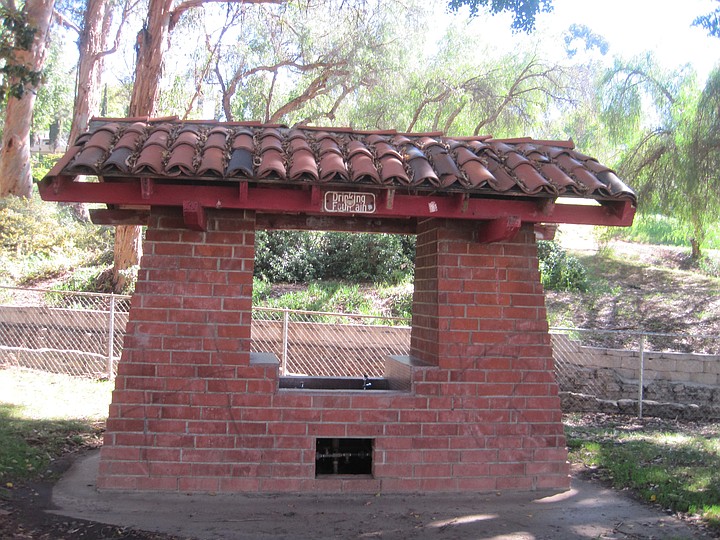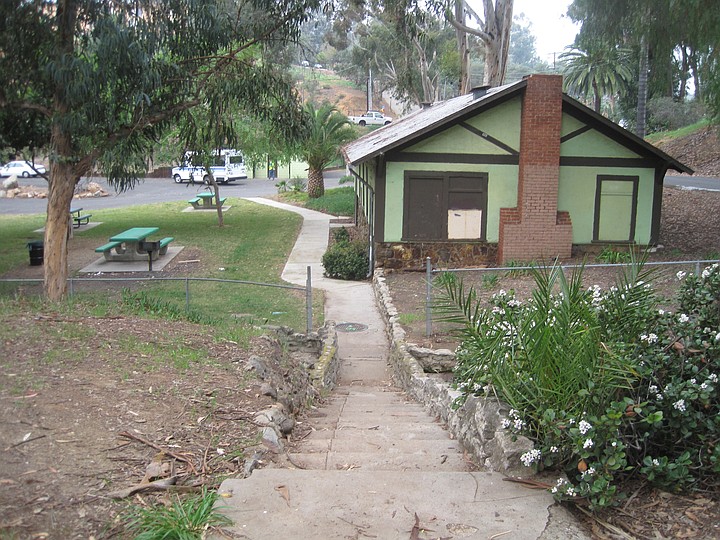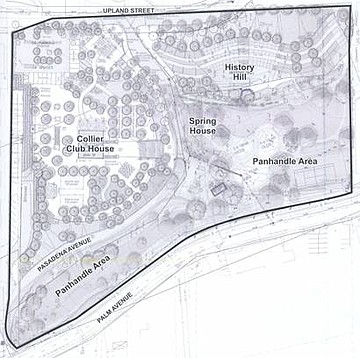 Facebook
Facebook
 X
X
 Instagram
Instagram
 TikTok
TikTok
 Youtube
Youtube

By 9:30 a.m. on February 25, Collier Park tennis-court nets were lowered for the pickleball games that are played Monday, Wednesday, and Friday mornings in La Mesa's oldest park. As players with paddles concentrated on a perforated ball, a woman wheeled a stroller through the parking lot.
A crew from St. Madeleine Sophie's Center wearing orange vests picked up trash in the 95-year-old, 7.7-acre park located at 4401 Palm Avenue. (The El Cajon center serves adults with developmental disabilities; City of La Mesa management analyst Kaaren McElroy says that the city contracts with the center for general clean-up of La Mesa's 14 parks.)

In the park, a man sat at a picnic table near the roof-topped water fountain. As I began taking pictures of the fountain, he told me, "It's older than hell."
The fountain originally located on the corner of La Mesa Boulevard and Spring Street was "erected in 1915 to bring spring water to downtown La Mesa," according to the Collier Park Renovations Project Master Plan that the La Mesa City Council unanimously approved on February 24. The council also voted 4-0 to certify the environmental impact report and approve related documents.

Before the vote, community-development director Bill Chopyk's report provided some history about the city, incorporated in 1912. The park is named for developer David Charles Collier, who bought the land with natural springs on it in 1905. Collier built a bottling facility on the property in 1907, a 1300-square-foot structure that residents refer to as the Spring House.
In 1910, Collier donated five acres for park use and the city acquired nearby land "for water purposes." In 1920, La Mesa developed a municipal park with a pool located where the tennis court is now. The pool opened in 1921, and there were dressing rooms in Spring House, according to the master plan. Spring House was also a meeting place until the city closed the deteriorating building in 1981.

The plan divides the park into four concept segments, and the document calls for short-term mothballing of Spring House, "a process of closing and protecting the building from weather and vandalism." The long-term plan is to pursue grants and other funding methods to restore or rehabilitate the building.
During street widening in the 1960s, the drinking fountain was "disassembled" and moved to the park. It was reassembled with the original roof frame and tiles and 1960s brick and stucco. The plan moves the fountain to the park entrance at the intersection of Palm and Pasadena avenues.
That change is proposed in Phase 1, the “panhandle phase.” Named for the panhandle shape of land in the southern and western portion of the park, the plan includes a new tennis court, a new restroom building, two gazebos, and three age-specific playgrounds for children between the ages of 2–5, 5–9, and 9–12.
Chopyk said the second phase, the “History Hill phase,” focuses on ways to generate funding. Plans include taking about 20 feet off the top of the hill surrounding the park. History Hill is primarily undeveloped land in the southeastern part of the park. Proposed improvements could include "a grassy amphitheater built into the hillside." In addition, a small portion of the area could be used as "rental space for weddings or similar events."
Construction of the Collier Park clubhouse in the northern part of the park could also generate funds. A 34-space parking lot is planned, and amenities could include an oversized chess set and bocce ball court.
Furthermore, Chopyk said a pipe sends spring water into a swale in the park. Testing by D-Max Engineering indicated the water is suitable for recreational uses and irrigation. He told the council that testing didn't "go to the extent of potable water, if that's something you want to [look into] in the future."


By 9:30 a.m. on February 25, Collier Park tennis-court nets were lowered for the pickleball games that are played Monday, Wednesday, and Friday mornings in La Mesa's oldest park. As players with paddles concentrated on a perforated ball, a woman wheeled a stroller through the parking lot.
A crew from St. Madeleine Sophie's Center wearing orange vests picked up trash in the 95-year-old, 7.7-acre park located at 4401 Palm Avenue. (The El Cajon center serves adults with developmental disabilities; City of La Mesa management analyst Kaaren McElroy says that the city contracts with the center for general clean-up of La Mesa's 14 parks.)

In the park, a man sat at a picnic table near the roof-topped water fountain. As I began taking pictures of the fountain, he told me, "It's older than hell."
The fountain originally located on the corner of La Mesa Boulevard and Spring Street was "erected in 1915 to bring spring water to downtown La Mesa," according to the Collier Park Renovations Project Master Plan that the La Mesa City Council unanimously approved on February 24. The council also voted 4-0 to certify the environmental impact report and approve related documents.

Before the vote, community-development director Bill Chopyk's report provided some history about the city, incorporated in 1912. The park is named for developer David Charles Collier, who bought the land with natural springs on it in 1905. Collier built a bottling facility on the property in 1907, a 1300-square-foot structure that residents refer to as the Spring House.
In 1910, Collier donated five acres for park use and the city acquired nearby land "for water purposes." In 1920, La Mesa developed a municipal park with a pool located where the tennis court is now. The pool opened in 1921, and there were dressing rooms in Spring House, according to the master plan. Spring House was also a meeting place until the city closed the deteriorating building in 1981.

The plan divides the park into four concept segments, and the document calls for short-term mothballing of Spring House, "a process of closing and protecting the building from weather and vandalism." The long-term plan is to pursue grants and other funding methods to restore or rehabilitate the building.
During street widening in the 1960s, the drinking fountain was "disassembled" and moved to the park. It was reassembled with the original roof frame and tiles and 1960s brick and stucco. The plan moves the fountain to the park entrance at the intersection of Palm and Pasadena avenues.
That change is proposed in Phase 1, the “panhandle phase.” Named for the panhandle shape of land in the southern and western portion of the park, the plan includes a new tennis court, a new restroom building, two gazebos, and three age-specific playgrounds for children between the ages of 2–5, 5–9, and 9–12.
Chopyk said the second phase, the “History Hill phase,” focuses on ways to generate funding. Plans include taking about 20 feet off the top of the hill surrounding the park. History Hill is primarily undeveloped land in the southeastern part of the park. Proposed improvements could include "a grassy amphitheater built into the hillside." In addition, a small portion of the area could be used as "rental space for weddings or similar events."
Construction of the Collier Park clubhouse in the northern part of the park could also generate funds. A 34-space parking lot is planned, and amenities could include an oversized chess set and bocce ball court.
Furthermore, Chopyk said a pipe sends spring water into a swale in the park. Testing by D-Max Engineering indicated the water is suitable for recreational uses and irrigation. He told the council that testing didn't "go to the extent of potable water, if that's something you want to [look into] in the future."
Comments